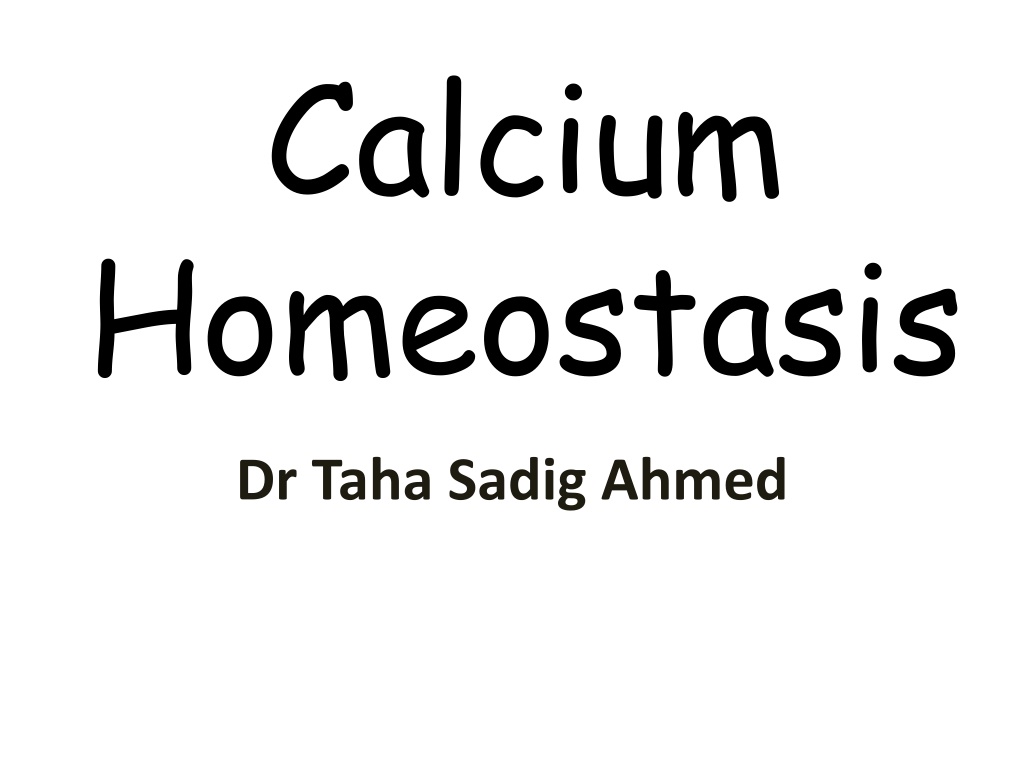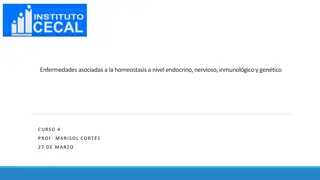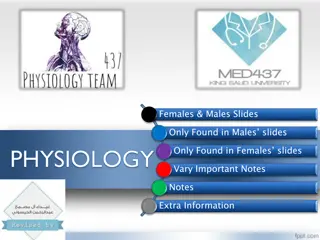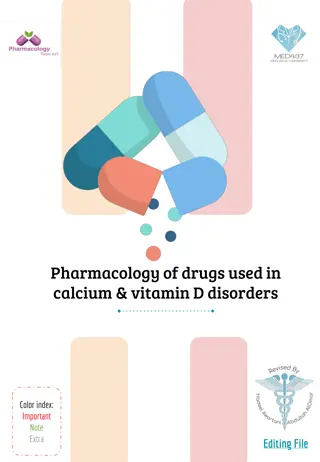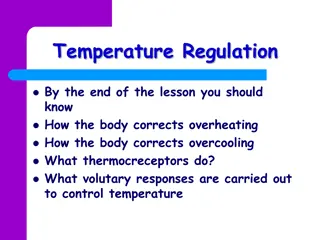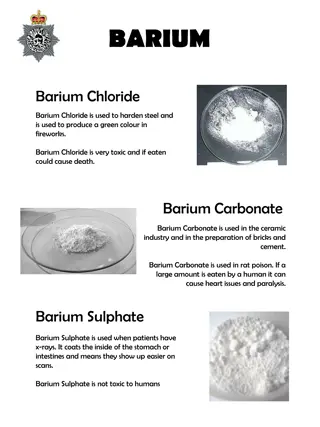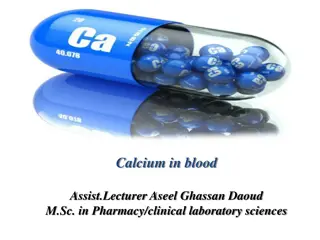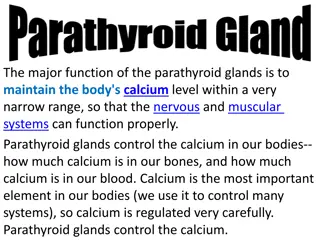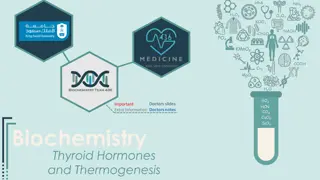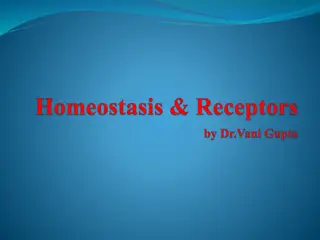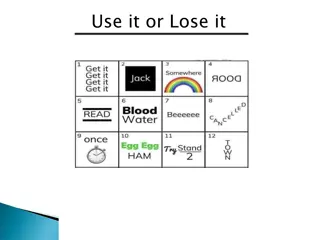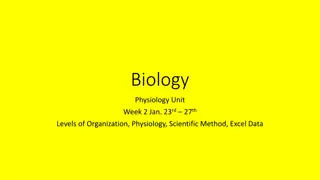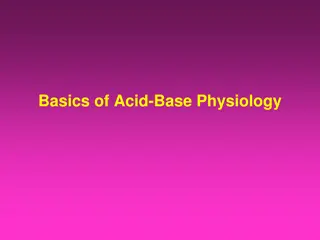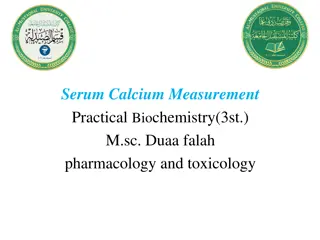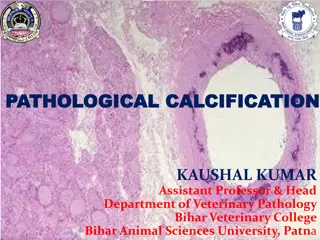Understanding Calcium Homeostasis and Its Importance in the Body
Calcium homeostasis plays a crucial role in various physiological functions, including bone integrity, blood clotting, enzymatic regulation, hormonal secretion, neurotransmitter release, nerve excitability, and muscle contraction. Bones act as a major calcium reservoir, with blood containing 50% ionized calcium crucial for biological activity. The non-ionized fraction is bound to proteins and anions. Imbalances in calcium levels can lead to issues like tetany, characterized by muscle spasms. Overall, maintaining proper calcium levels is essential for overall health.
Download Presentation

Please find below an Image/Link to download the presentation.
The content on the website is provided AS IS for your information and personal use only. It may not be sold, licensed, or shared on other websites without obtaining consent from the author. Download presentation by click this link. If you encounter any issues during the download, it is possible that the publisher has removed the file from their server.
E N D
Presentation Transcript
Calcium Homeostasis Dr Taha Sadig Ahmed
Physiological Importance of Calcium Calcium is essential for normal (1) structural integrity of bone and teeth . (2) Blood clotting ( coagulation ) . (3) Enzymatic regulation . (4) Hormonal secretion . (5) Neurotransmitter release ( e.g. ACh release at the NMJ ). (6) Nerve excitability ( normal ECF Ca2+ concentration is essential for neuronal membrane stability & RMP ) (7) Muscle contraction .
Bone serves as a major reservoir for Ca++storage : 99% of calcium is in the skeleton . However , very little Ca2+can be released from it . Calcium is present in bone as calcium phosphate .
Calcium in blood The total blood Ca++concentration is around = 10 mg / dl It exists primarily in 2 equal fractions , each one comprising 50% of the total blood calcium (5mg/dl) (A) Free , ionized Ca++( free to react ) 50 % of total blood calcium Ca++= 5mg/dl (B) Non-ionized ( bound ) Ca++ 50 % of total blood calcium Ca++= 5mg/dl Because it is free and unbound , the ionized Ca++is the only form of Ca++which is biologically active. The non-ionzed fraction is bound & not free & not biologically active .
(B) The Non-ionized ( non-free, bound) ) Calcium This non-ionized ( bound) calcium (50% of ECF calcium ) in turn is divided into (1) Protein-bound around 40% of total ECF calcium .It is bound mainly o albumin , & a smaller fraction is bound to globulin (2) Complexed ( bound) to anions ( Phosphate , Sulfate & Citrate ) forming complexed salts of them) 10 % of total ECF calcium .,
Binding of calcium to albumin is pH-dependent Acute respiraqory alkalosis increases calcium binding to protein thereby decreases ionized calcium level When ionized calcium falls below normal, permeability of neuronal cell-membranes to sodium increases depolarization hyperexcitability of the nervous system patients become prone to develop Tetany , tetanic muscle contractions & seizures .
Binding of calcium to albumin is pH-dependent Acute respiraqory alkalosis increases calcium binding to protein thereby decreases ionized calcium level When ionized calcium falls below normal, permeability of neuronal cell-membranes to sodium increases depolarization hyperexcitability of the nervous system patients become prone to develop tetanic muscle contractions & seizures .
99% of total body Ca++ is contained in bone. Bone is not a fixed unchanging tissue, it is constantly being remodeled it can either withdraws Ca++ form ECF or deposit it there. Increase in protein con. in total ca++ con. Decrease in protein con. In total ca++ con. The effects on ionized Ca++ conc. are in significant. Changes in anion con. Alter the ionized Ca++ con. e.g. plasma phosphate con. The conc. of Ca++ complex to phosphate ionized Ca++ con.
Hormonal Regulation of Calcium 3 principal hormones regulate serum Ca++ level . 2 of them increase it : (1) Vitamin D3 (1,25-dihydroxy ) ( taken in food & synthesized in the skin ) (2) Parathyroid hormone (PTH) : polypeptide hormone secreted by Parathyroid Glands . And the third one one decreases it : (3) Calcitonin : polypeptide hormone secreted by Parafollicular (C ) cells of Thyroid Gland NB : While PTH and vitamin D act to increase plasma Ca++ only calcitonin causes a decrease in plasma Ca++.
Calcium ion concentration in the ECF is maintained by Bone Intestine Kidney
Hormonal Regulation of Ca++: Vitamin D3 increases blood Ca++ level by (1) stimulating dietary calcium absorption by the intestine (2) stimulating osteoclasts ( that remove calcium from bone ) Parathyroid hormone ( PTH) increases Ca++ levels by (1) stimulating Ca++ resorption from bone ( by activating, osteoclasts ) passing Ca++ to the ECF (2) Stimulating Ca++ reabsorption (and phosphate excretion) by the kidneys Calcitonin decreases blood Ca++ levels by stimulating bpne forming cells (osteoblasts ) and inhibitong bone- resorbing cells ( osteoclasts ) .
Vitamin D Keratinocytes in the skin synthesize 7-dehydrocholesterol . 7-dehydrocholesterol is photoconverted ( by UV light in skin) to Cholecalciferol (previtamin D3 ) , This form of Vitamin D is inactive, it requires modification to the active metabolite, 1,25-dihydroxy-D by two hydroxylation reactions the first one occurs in the liver and the second one in the kidney When there is limited exposure to the sun , dietary vitamin D is essential . If there is no sufficient exposure to the sun , or if there is ditary deficiency in vitamin D Rickets ( in children ) or Osteomalacia ( in adults ) occur . PTH stimulates Vit D synthesis
Vitamin D deficiency leads to a disease characterized by softening of bone If it occurs in choildren it is called Rickets If it occurs in adults it is called Osteomalacia Most affected areas : Metaphyses of long bones subjected to stress Wrists Knees Ankles
Clinical Features Delayed dentition ( delayed teething ) Bowed legs(due to the effect of weight bearing on the legs) and Short stature Swelling of wrists and ankles Rachitic rosary Craniotabes
Osteomalacia- an adult disease characterized by a gradual softening and bending of the bones Metaphyseal widening in wrists & knees + signs of bone rarfaction Bowed legs ( Bowing of legs ) Knock-knees
